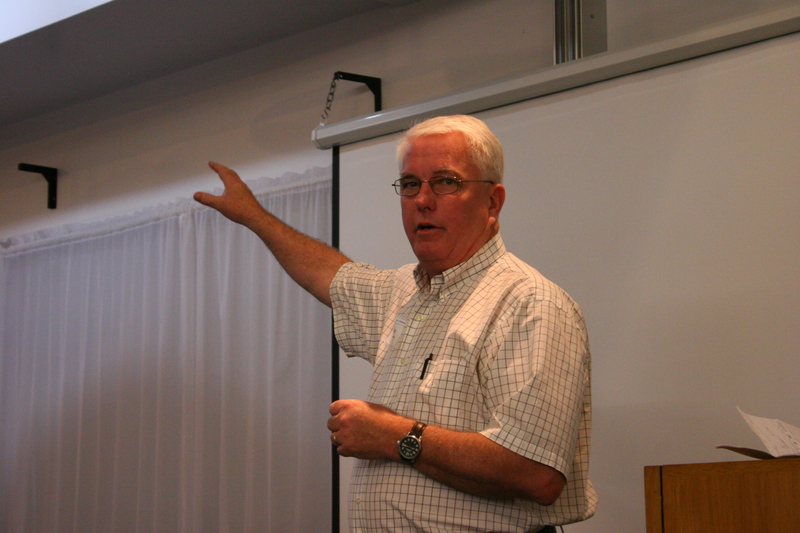Ed Lewandowski says it would be great if he could walk into a local seafood restaurant and see farmed Indian River oysters on the menu.
Oysters are tasty, and they're also known for their ability to filter vast quantities of water, while creating or improving key habitat areas for a plethora of game and feeder fish.
But, Lewandowski, executive director of the Center for the Inland Bays, might have to wait a while.
While Virginia's Chincoteague oysters and Maryland's Chesapeake and Choptank oysters are well known, Delaware is the only ocean-boardering East Coast state without commercial shellfish aquaculture. The Center for the Inland Bays views oyster farming as a way to improve water quality, but officials say opening the Inland Bays to commercial aquaculture will take some work.
Roy Miller, environmental policy coordinator at the center, said "Any proposal of open water aquaculture would be groundbreaking." Miller, also a retired Department of Natural Resources and Environmental Control fisheries section administrator, said a commercial oyster farm would have to get permits from:
-Delaware Department of Agriculture
-DNREC Fish and Wildlife
-DNREC Division of Water, and its Wetlands and Subaqueous Lands Section
-DNREC Division of Watershed Stewardship
-DNREC's Shellfish Program
An oyster farm might also need a permit from the U.S. Army Corps of Engineers, he said.
All that is only the beginning. Under state law from the 1970s, no one can get a lease in Rehoboth Bay or Indian River Bay until the state surveys the bottom and holds two hearings in Rehoboth Beach, Miller said. One meeting was held in February 1979. After the hearings, the legislature must approve a bays management plan that was submitted in 1979. It was never approved.
Miller says it will take popular support to get the process moving forward again. He suspects the General Assembly failed to take action in the 1970s because it didn't feel a groundswell of support for commercial aquaculture. "If the legislature takes action, I think it will be in response to constituent advocates," Miller said.
Miller spoke at a June 18 conference hosted by the center, DNREC and the University of Delaware Marine Advisory Service. At the conference, shellfish experts, environmentalists and watermen gathered to discuss the possibility of commercial oyster aquaculture in Delaware's Inland Bays.
Delaware food production
Delaware Secretary of Agriculture Ed Kee opened the conference, sharing a list of factoids about food production in Delaware, which lies within a 8-hour truck ride of 80 million people.
Kee said he shares Lewandowski's vision of seeing Inland Bays oysters in area restaurants. "I think we can get there," Kee said. "I'm enthusiastic about this meeting and your mission."
Kee said he is interested in exploring commercial oyster farming in Delaware, and so are Gov. Jack Markell and DNREC Secretary Collin O'Mara.
"We export our food, but we have a strong local market for Delaware products," said Kee, who visited the Historic Lewes Farmers Market just before the conference. He said Delaware produce is shipped as far as Miami and Montreal.
"But I don't want to lose sight of the importance of local," Kee said. He said there's a renaissance in interest in locally-sourced food.
For growers to be successful, Kee said, they will have to produce reliable products and deliver them on time. They also have to provide safe foods. "That food safety piece has grown exponentially in the last five to six years, and it's a big, big deal. It's changing agriculture," he said.
"The only thing I know about aquaculture is I like to eat every species you produce," he said. "If we want to capture the environmental and recreational benefits, we must do it in a way that's economically sustainable."
Kee said commercial aquaculture is under the jurisdiction of his department, and state code proposes a structure for an aquaculture council that has been inactive for decades.
Lots of industry models
John Ewart, University of Delaware Marine Advisory Service finfish and aquaculture specialist, said there are plenty of aquaculture programs in other states to look at. "We won't be reinventing the wheel here," he said.
Shellfish can be grown on the bottom, with or without predator nets; they can grow on the bottom in bags, trays or on reefs; and they can be grown off the bottom in racks, bags, rafts or on lines, Ewart said.
Shellfish farmers must lease the water column or the bottom from the state or federal government, depending on where the farm will be placed, Ewart said, noting there are already 1,000 shellfish farms in East Coast states.
Oyster gardening in the bays
Oyster farming returned to the bays in the 21st century when the Center for the Inland Bays began oyster gardening, growing oysters for water-quality improvement, not for harvest and sale.
In 2003, the center began farming oysters at 13 locations in the bays; this year, more than 200 volunteers tend oysters at 130 locations, mostly in Little Assawoman Bay, Ewart said.
Center Restoration Coordinator E.J. Chalabala said the bays are at a crossroads: people need to strike a balance between development and environmental protection. The bays are at risk from excessive nutrients introduced into the system from development, farming and animal waste, he said.
Years of data from the center's gardening program show oysters will grow well in the bays, he said.
Ewart said after the center acquired the James Farm, center staff and University of Delaware scientists installed a flat, quarter-acre oyster reef inside Pasture Point. He said the center plants young oysters from a disease-resistant strain developed by Rutgers University.
Young oysters were spread at natural densities with no protection from predators, he said. The first season was great, but the next year the oysters suffered during a bloom of sea lettuce. That winter, they were exposed to very cold temperatures during a low tide and many died.
Ewart said when oysters are grown using "gear" – floats or other off-bottom devices – as many as 80 percent to 90 percent of oysters survive. "The structure helps a lot," said Ewart, noting that research by Delaware State University students has proven there is a great abundance of sea life in and around the oyster gear.
Oyster-growing equipment provides more nursery habitat than flat reefs on the bottom, said Ewart.
Starting an industry
Speakers from Maryland, Virginia and Rhode Island discussed oyster farming in their states, how it's regulated and some problems they have encountered along the way.
Bob Rheault, executive director of the East Coast Shellfish Growers Association, started his oyster farming business in Point Judith Pond, R.I. When he sought his first lease, Rheault said, aquaculture in his state was functionally illegal and obtaining a permit was very difficult.
He said science has shown oysters are very effective at removing nitrogen from the water, making water clearer and creating a healthier habitat.
Rheault said he has found many baby sport fish in his oyster cages, as well as feeder fish and lobsters. "Oysters are ecosystem engineers," he said.
Two-thirds of the nations' rivers and coastal waters are degraded because of nutrient pollution, Rheault said, and oyster farming could help remedy that problem.
Tommy Leggett, an oyster farmer who also coordinates the Chesapeake Bay Foundation Virginia Oyster Restoration Center, described his side business, in which he grows 100,000 oysters a year.
Leggett said he works between 15 and 20 hours a week growing oysters in Virginia, which has an extensive history of oyster farming. Leggett grows a specific type of oyster with extra chromosomes, called a triploid. Because they do not reproduce, triploids put more energy into growth, resulting in an animal that hits commercial market weight earlier than a standard oyster.
He said farming is catching up to commercial landings, but he does not expect any states will see extensive aquaculture like that practiced in other nations, including France and China. He said because so many people use the bays, they are not likely to tolerate large-scale development.
Leggett said he selected the land for his lease because it was an out-of-the way section of a creek. Striving to be a good neighbor, he said he tries to make friends with other water users to help avoid controversy.
"Start small. There is a learning curve. I've seen several fall on their face and fail," he said. "It's better to screw up with a small amount."
Leggett said branding and marketing are also very important for successful farming. He said oyster seed is the most expensive part of his operation; Virginia charges a yearly lease fee of $1.50 an acre.
Rheault said Rhode Island charges $175 an acre per year.
Bill Baker, fishing boat captain and member of the center's Water Use Implementation Committee, said he's discussed the prospect of commercial oyster growing with local fishermen and has found no opposition. He said the fishing community sees oyster farming as a way to help clean bay water while generating jobs and income.
"I told them they'll have to mark off areas where there'll be oysters, and they say that's OK, because oyster beds attract more fish," Baker said.
Chris Bason, deputy director of the center, said the center plans to publish a short white paper outlining information provided at the conference.
Lewandowski said center staff plan to meet Kee in the coming weeks to discuss logical next steps in developing the oyster-farming industry.
Aquaculture: It's nothing new
John Ewart, University of Delaware Marine Advisory Service finish and aquaculture specialist, said aquaculture began in Egypt and China in 2,500 B.C.
Fan Li wrote the first book on the subject in 475 B.C., Ewart said, and there are records of Roman aquaculture from the first century B.C.
The first fish hatchery in the United States opened in Wisconsin in 1887 and southern states began farming trout and catfish to replenish depleted stocks in inland waterways.
Since then, Ewart said, aquaculture production has picked up and represents about half the total landings.
Oysters and mollusks make up about 46 percent of the total commercially farmed seafood in the world, said Ewart.
China produces 67 percent of the world's total seafood; more than 90 percent of seafood production comes from Asia and China, said Ewart. The United States is at the bottom of the world's top 10 producers and imports about 80 percent of its seafood. Less than 2 percent of that is inspected by the Food and Drug Administration, he said.
"I think it's a serious food-security and food-safety issue," Ewart said. He said the country is running a $10 billion trade deficit on seafood, and he expects that number to rise.
Ewart said aquaculture is the fastest-growing segment of the global food market.
White gold of the Inland Bays
If the state develops commercial oyster farming in the Inland Bays, it will not be the first time the bivalve mollusks have been commercially harvested from those waters.
Center Deputy Director Chris Bason spoke to the conference about the history of oystering in the Inland Bays, from the Nanticoke Indians through commercial fishermen into the 20th century.
Delaware once called oysters "white gold," Bason said. In 1852, the state began to restrict the harvest from May 1 through Aug. 10 to prevent overharvesting, a practice that gave birth to the Big Thursday festival, which still takes place every year in Millsboro.
In the early 20th century, shoaling caused the Indian River Inlet to close periodically, which also damaged the industry, Bason said. The federal government stepped in during the 1930s to stabilize the inlet and protect fishermen's ability to harvest and get their oysters to market.
In 1948, more than 3,100 acres, or 34 percent of Rehoboth Bay and 1,100 acres, or 13 percent of Indian River Bay, were used for commercial shellfish harvesting.
"Even if only 15 percent was oysters, think about the environmental impact, the effect on water quality, water clarity and nitrogen removal," Bason said.
The oyster industry took another hit in the 1930s with the arrival of disease. The industry quickly fell off, said Bason. The last oysters were planted in the bays in 1978.
Fishermen switched to clam harvesting, and people took down the stakes that marked oyster beds, he said.

























































